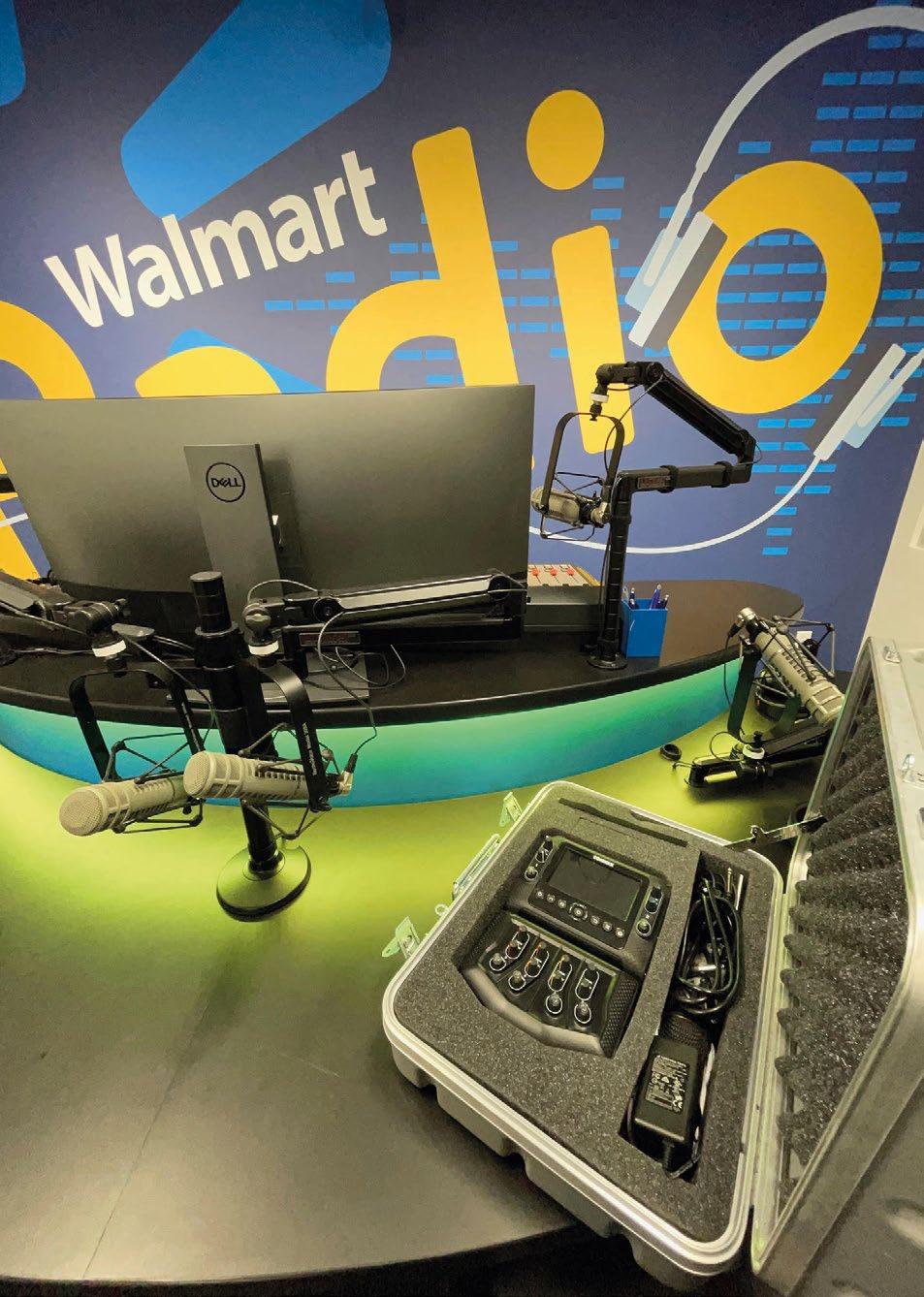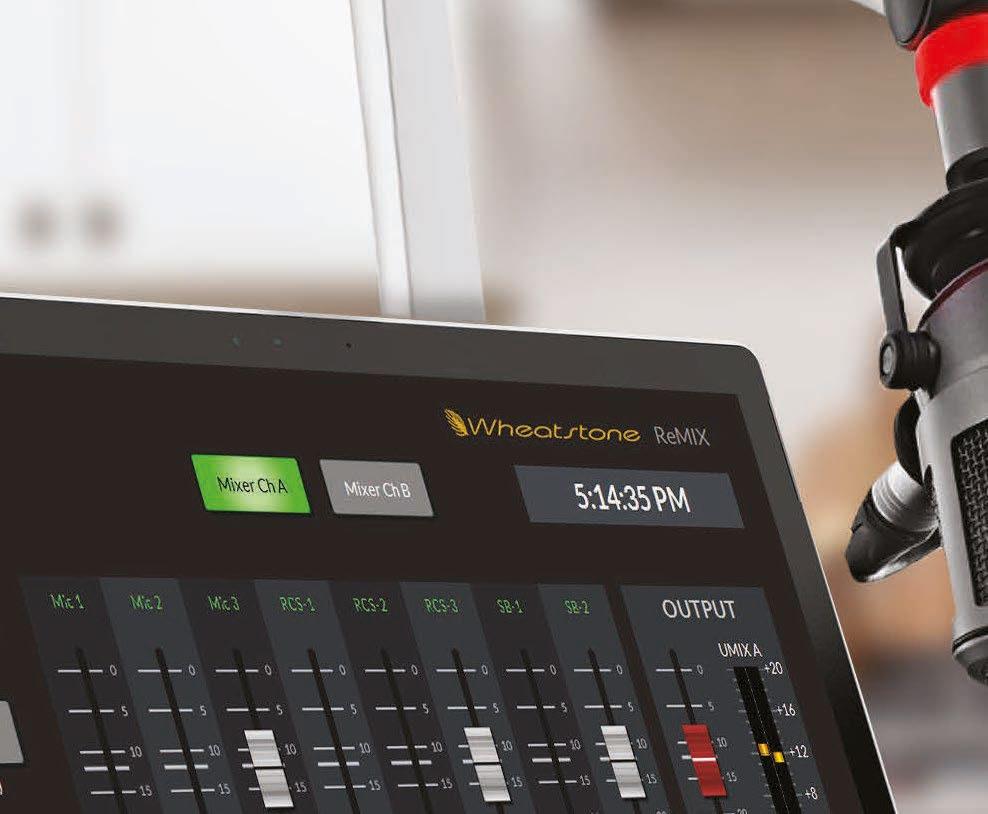
5 minute read
Versatility of Access keeps Walmart Radio flexible
Writer Bo Woloszyn
Host, Walmart’s “The Bo Show”
Info
Contact Chris Crump at Comrex at 1-978-7841776 or visit www.comrex. com.
Above Right
In this “fisheye” photo, the Comrex Access NX Portable codec and its accessory mixer are shown in a carrying case.
Versatility of Access keeps Walmart Radio flexible
Attention, shoppers, you’re listening to Walmart Radio via Comrex Access
Walmart Radio was created in the late 1990s. It was discontinued temporarily in 2008, and Walmart stores and Sam’s Clubs switched to playing CDs over their PA systems. But a CD can only hold so much music, and it hit the point where store associates knew what time of day it was based on the song that was playing.
In 2015, during a meeting with the CEO of Walmart, a store manager said that they really needed Walmart Radio back. It was reintroduced on the spot.
I am a manager in the corporate affairs and corporate communications team for Walmart and Sam’s Club, and my primary job is to oversee the radio aspect of our stores and clubs. I also host “The Bo Show,” which airs live in all locations on Mondays, Wednesdays and Fridays in the afternoons.
We run it just like any other terrestrial radio show, except we syndicate in a retail environment. I do interviews with celebrities, shout-outs for associates, take calls from customers, and play games on the air — the kinds of things you’d expect to find on any national radio show. Additionally, my colleague hosts a morning show called “Live with Antonio,” and we’ll regularly do remote events along with other special programming.
Packing a punch
I’ve worked in radio for over 20 years, and spent much of that time working in terrestrial radio. In that time, I’d used plenty of Comrex gear, and I really liked it.
During the pandemic, we realized that we needed to upgrade some of our equipment. The TV division of Walmart was using some Comrex stuff already, so the name was familiar. When it was time to shop for new equipment, I thought, “Hey, this is a good company, I know the stuff — let’s give it a try.”
During the pandemic, when the main office itself shut down, a lot of our associates began working remotely. Our stores were still open, though obviously with limited capacity; and we wanted to be able to do our show, even though we couldn’t be at the studio.
We owned a single Comrex Access 2USB unit, but that wasn’t enough to handle everything we needed to do since we were all about to be working from home. So we purchased several Access NX units, the newest portable IP audio codec from Comrex, so that we could give them to everyone who needed one.
We also needed a studio codec that could handle multiple remote connections at once. After bit of research, we chose the Comrex Access MultiRack, which can handle up to five connections with any kind of Comrex IP codec simultaneously. Once everything was installed, we were off to the races!
One of the things I like about the Access NX is that it’s small, but it packs a punch. It has a lot of bells and whistles, especially when you add the extra mixer.
I’ve used it with Wi-Fi, cellular networks and also with a hardwire connection through a cradle point. The battery lasts quite some time, so you can get through a good two- or three-hour broadcast on battery power alone when connected to the mixer. Without the mixer, it can last up to 5 hours.
Having used this gear for a year, I think it’s one of the best upgrades we’ve ever made. It was essential during the pandemic. We could connect from home, and I could also log into the user interface remotely if there was ever an issue. The flexibility on it is just amazing — it’s one of the best units I’ve used in my radio career.
Tech Update 2wcom HDR-CC Is a Small Box With Impact
2wcom says its HD Radio Capture Client (HDR-CC) solution eases configurations not only for audio acquisition but also output for emergency alerts. It plays well with Generation 3 or 4 HD Radio systems.
The palm-sized box can take in one digital or analog stereo audio channel and provide it to an HD importer. The audio is sent compressed with an HD Radio codec via IP. Thanks to the HDR-CC’s audio-over-IP capabilities, the device can also put studio or web radio streams (e.g. Icecast) directly on-air over one of the supplemental HD radio channels.
The connection to the importer is established by entering its IP address in the web interface and connecting audio via XLR connectors.
The company says one big advantage is to help broadcast enterprises comply with FCC emergency alerts rules, which had necessitated the use of external audio switches.
Because of a feature implemented by Xperi into the latest Generation 4 importers, the entire emergency alert for all supplemental channels on the transmitter can be provided by a single HDR-CC. It requires a setup that has AES audio connected to the capture client as well as a GPI to trigger the alarm. When the alarm is triggered the HDR-CC logs into the importer and replaces all supplemental channels (HD2–HD4) with the alarm program. After the GPI is released, the HDR-CC logs out and the importer returns to regular operation.
The HDR-CC is powered with Power-over-Ethernet or external power supplies.

For information, contact 2wcom in Germany at +49-461-6628300 or visit www.2wcom.com.


IT’S ALL IN WHEATNET-IP THE INTELLIGENT NETWORK
SET UP A HOME STUDIO IN MINUTES
Our software (and hardware) solutions provide intuitive tools to let you work from home seamlessly, with minimal setup.

REMOTE SOLUTIONS
Learn more: wheatstone.com/remote-solutions-rw21a







